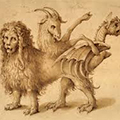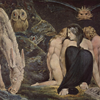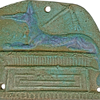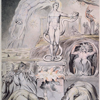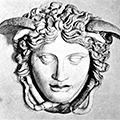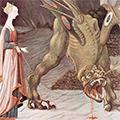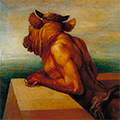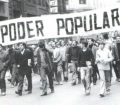Miguel Bernardo Olmedo Morell [*]
Resumen. Prácticamente cada religión y mitología tiene su propia versión del Apocalipsis. Y no son las únicas: la mayoría de las tradiciones literarias y múltiples formas de ficción parecen centrarse en mostrar el fin del mundo de todo tipo de formas. A lo largo de este ensayo trataré de mostrar, a través del análisis de la obra de Kurt Vonnegut Matadero cinco, que tener un mito del Apocalipsis puede cumplir ciertas funciones sociales y psicológicas, convirtiéndolo así en una herramienta bastante útil para dar sentido a nuestro mundo.
Palabras clave: literatura norteamericana, Kurt Vonnegut, Matadero cinco, mitología, Apocalipsis
Out there in the sky, light years away, the Tralfamadorians experiment with a new kind of fuel that will eventually backfire, explode and destroy the whole of the universe. That event has happened, is happening and will always happen, and only the mind of a human would harbour such outrageous thoughts as trying to stop it. But it’s alright, the Tralfamadorians say. The universe can end. Life will go on anyway. So it goes.
1. Preliminary considerations about the apocalypse
The most basic assumption we should take into account while dealing with the idea of the Apocalypse is that the myths of the Creation and the Destruction of the world are nothing but the mythological displacement of the human experiences of life and death. But how do they work?
Everything that has a start has to end, sooner or later. We are so bent on this precept that we try to establish clear-cut limits between one historic period and the following, despite the fact that no era automatically turns into another in the space of, say, a month. And when we look up an important person on an encyclopedia, the first data we are given is the dates of their birth and death. We need to know the exact year something started and the exact year that something ended. That is the only way our mind is able to process a concept, by creating clear temporal boundaries.
That is one of the main reasons why almost every religious movement tends to have a creation myth as well as an end-of-times myth. This structure, clearly present in the Bible—it opens up with god creating the world in the Genesis and ends with the Judgement Day in the Book of Revelation—can also be found in Norse mythology—the gods creating the world from the remainders of the body of the giant Ymir as the creation myth (Prose Edda: 16-17), and the very well known episode of Ragnarök, where almost every world will collapse, as the end-of-times myth (Prose Edda: 71-77)—and even in the medieval literary tradition of Arthurian romance, where their chivalric world begins, in such works as Geoffrey of Monmouth’s Historia Regum Britanniae or Wace’s Roman de Brut, with Arthur driving the Saxons away from Britain (Weiss 2010: 237) and being crowned as king of a new society (Weiss 2010: 261) — note the similarity to Frye’s myth of spring [1], by means of which a new society, a new «world» is created. This newly created world also finds an end, in a very similar way to that of Ragnarök, in the great battle against Mordred in the Mort Artu of the Vulgate Cycle, where almost every single knight of the Round Table dies [2].
Another very characteristic element of these Creation/Destruction cycles is the presence of a «seed», a spark of life that, very much like the little flower found in the desolate scene from Picasso’s Guernica (1937), remains after the world has ended, and is susceptible of creating a new one or, at any rate, a new society. This is the case of the everlasting souls of the righteous which, after Judgement Day, will go on living in the world to come; of the survivors of Ragnark that will repopulate the world once more (Prose Edda: 77-78) [3]; or of the famous Breton Hope that assured that King Arthur had survived the battle against Mordred and would one day come back to reign once more. In mythical terms, we would understand this schema as an instance of the cycles of nature following one another: the Creation myth would correspond to the Spring, when life blooms and an air of beauty and innocence pervades all throughout the world; the Apocalypse myth would be related to Winter, the end of the cycle, when life fades out and dissolves after death; but the seasons then restart their cycle with Spring once again as they begin a new year, a new page of history, instead of coming to an absolute end. This is the moment when the aforementioned «seed», after surviving through the Winter, blooms once again and creates a new world [4].
This quick overview may lead us to ask ourselves, why do we need the world to end? However, it is not difficult to ascertain why every religious movement would want to have a myth of Creation and a myth of Destruction. In fact, as I will try to prove in this paper, the existence of the Apocalypse fulfills at least three functions:
- It has a rationalizing function. We are human beings and our lives are limited. We are born on a certain day of a certain year, and we die just the same. Our childhood is the space of innocence, our Spring; death comes after we have passed the weather-beaten days of Winter. We have temporal limits, and so we tend to project them onto the whole of creation and every element within. As Kermode puts it, «To make sense of their span they [men] need fictive concords with origins and ends, such as give meaning to lives and to poems […] the End is a figure for their own deaths» (Kermode 2000: 7).
That is precisely why we are so bent on the idea that after Winter, Spring comes yet again. We want to live after we die.
- It has a prospective function. In Catholicism, we are told not to despair because of the injustices of the terrestrial life, for we will find true justice when Judgement Day comes and the sinners are punished, whereas the meek will be rewarded. The Norse knew what moral code to follow: they knew they should die fighting if they were to go to Valhalla [5]. Even stricter were the chivalric values of the Knights of the Round Table, which were influenced both by heavenly rules and earthly norms of conduct. We can conclude, then, that establishing a well-defined end has a prospective function, for it tells us how to behave so as to achieve a future glory. Or, in other words, we need to know when and how things will end in order to know what we’ll do in the meantime, in the same way that, in the middle of the summer, we need to know that the winter will be cold in order to buy warm clothes.
Even agnostics and atheists are influenced by the expectation of the end, even if in this case the only end we are waiting for is that of our individual lives. This has resulted in different death-oriented movements, such as the hedonistic carpe diem—or, to put it in urban jargon, «YOLO», «You Only Live Once»—or psychoanalysis as a means to accept and come to terms with mortality [6].
- It has a comforting function, for it helps us cope with death and decay. We should not forget that having an Apocalypse myth implies, in varying degrees, a certain fatalistic perspective of the world, for, at the very least, the end of the world is a fixed point in time which cannot be prevented [7]. This serves the function of making us come to terms with the death of all that we hold dear and, eventually, of our very own lives, which is a necessary step to take if we don’t want to live in anguish. As Beth Schroeder says, «Vonnegut sees fatalism as a coping mechanism that allows a person to slip blissfully, thoughtlessly, into the mindless routine of daily existence» (Schroeder 2003: 82). Even if this statement may seem a little judgmental, the main premise it contains still holds true: having an Apocalypse puts our individual lives, and our individual deaths, into perspective.
2. Billy Pilgrim and his apocalypse
This whole introduction was essential because it explains the mental process that goes on in the mind of Slaughterhouse Five’s main character, Billy Pilgrim. This work is so convenient for studying the Apocalypse precisely because Billy spontaneously creates a new «religion» by taking ideas from his life experience and tries to make sense out of everything around him in relation to these ideas; it is Joseph Campbell that said that «in the absence of an effective general mythology, each of us has his private, unrecognized, rudimentary yet secretly potent pantheon of dream» (Campbell 2008: 2), meaning that, when an individual doesn’t have an already established personal religious belief, he will produce his own mythology by using whatever symbols are available to him, which incidentally is exactly what Billy Pilgrim does. Interestingly enough, this «religion» also has an Apocalypse which, as I will argue, fulfills the three functions I have pointed out before [8].
Billy Pilgrim is a feeble man. He lacks any firm convictions that will get him through the war. He doesn’t have any kind of heroic motivation that makes him think of World War Two as righteous or of himself as a hero, or even a will to go on living. He’s just a tiny, little man that has sunk into a big, deep conflict. His rationalizing skills are far too small to make sense of, arguably, the biggest and most irrational event in human history, to the point where he ends up in a mental institution. Even after the war has ended, life seems so big for him that he will just let it flow as a stream that drags him effortlessly to his death—as evidenced, very illustratively, by the drawing on his grave of the epitaph «Everything was beautiful, and nothing hurt» (100)—. He doesn’t love Valencia —«Billy didn’t want to marry ugly Valencia» (88)—or even desire her—as evidenced by his being unfaithful to her in the New Year’s eve of 1961 (37) and his multiple delusions about being mated with Montana Wildhack in Tralfamadore (21)—but still marries her and lives with her until she dies. He doesn’t seem to care much about the plane crash of which he was the only survivor. He apparently doesn’t care about anything.
But he does. He has sexual desires, which he only lets out while being drunk or in his fantasies. He wants to be heard and appreciated, as is shown in his delusion of being applauded by a big crowd who love his ideas about time travel and flying saucers. But he hasn’t moved on from the war, which he constantly relives, and thus is unable to succeed in any field of his life. In her article «Diagnosing Billy Pilgrim: A psychiatric approach to Kurt Vonnegut’s Slaughterhouse-Five», Susanne Vees-Gulani asserts that «psychologically, Billy has never fully left World War II; instead, in Jerome Klinkowitz’s words, he lives in a “continual present”» (Vees-Gulani 2003: 177); that is why he uses his imagination «as a sense-making tool to deal with his war trauma» (id.: 176). This imagination, full of the imagery from Kilgore Trout’s sci-fi books, makes him create such wish-fulfilling fantasies as his having sex with Montana Wildhack (109), becoming an important and renowned man whose theories are heard and applauded by everyone (117), and, most importantly, his theory of time and the fatality of all events. Those events, as a Tralfamadorian explains to him, include the end of the world [9].
2.1. The rationalising function of the apocalypse
This quotation from the very beginning of Billy’s story shows that he, in his mind, needs to revisit the very beginning and the very end of his life so that he can understand what’s happening in-between. But why does he need to do that? Frank Kermode skillfully answers this question when he affirms that «there is still a need to speak humanly of a life’s importance in relation to it [the world and its age]—a need in the moment of existence to belong, to be related to a beginning and to an end» (Kermode 2000: 4).
Billy had never had any solid religion to give him comfort or make him feel protected [10]. As has been said before, this resulted in his having to create a whole mythology from scratch to help him cope with life, for he found it to be meaningless.
This religion, having been created from sci-fi novels and his own experiences, is not very imaginative or symbolically rich. The Apocalypse, for instance, comes to happen when the Tralfamadorians experiment with new sources of fuel, instead of happening because of a big war or some God judging his creation. But thanks to this new «religion», everything makes sense. Thanks to it, Billy can live peacefully with the prayer on his office that reads:
This idea of a spontaneous religion as a means to explain the world around him sounds very good and logical. What may not be clear at first, then, is why he needs to create an apocalyptic scenario in his wish-fulfillment fantasies. The answer is simple: he does so to establish boundaries, to make everything around him make sense. There is no doubt about him needing those, because, during his «time-travel» experiences, he always pays a lot of attention to dates, to the point he has even imagined the exact day and hour he will die. But that is not enough. That would only help him understand his life, and he needs more than that. He needs to understand the world in order to be part of it.
That is exactly why we need the myth of the Apocalypse. That is why almost every religion has a story of the end of times. Because a full comprehension of the world has to include not only the beginning, but also the end. It is not but after he has created this whole body of pseudo-religious belief that Billy finally begins to take an active interest in society: he starts participating in radio programs, writing letters to newspapers, thinking of himself giving speeches before large crowds…
Surprisingly enough, it is having the idea of the Apocalypse and his own death in mind that makes Billy Pilgrim be able to move on in life, for at least he knows what’s in store for him, as opposed to the confusing and bewildering experience of World War Two.
2.2. The prospective function of the apocalypse
A Tralfamadorian—a projection of Billy’s mind taken directly from the alien in The Gospel from Outer Space (89)—tells him about how the world will end when its people start experimenting with new fuels and a test pilot presses a button. The last remainders of Billy’s free will then ask the alien why they don’t try to stop the end of the universe from happening, as they possess the knowledge of how it will unfold. The alien replies what has become on of the main tenets of time travel: that moment is fixed in time. «He has always pressed it, and he always will. We always let him and we always will let him. The moment is structured that way» (96). There is no changing it—or anything at all, for that matter. We are just helpless creatures that wander down the streams of time. That is when Billy understands that there is no changing the flow of time, and that he must let life just set itself into motion.
With very similar words to those of the heading of this section, Billy Pilgrim addresses his audience in Chicago. He is telling them everything about «flying saucers and the true nature of time» (116), very much like a prophet before his congregation. And, exactly like one, he talks about how he is going to die one hour from that moment. The crowd protests. The police protests. The people around him are a lot like devouts who still don’t fully comprehend the message of their messiah and thus don’t want him to die. But he has finally understood the message of the Tralfamadorians when they told him about the Apocalypse and why it wasn’t a big deal for them. Now he knows he mustn’t fight a moment fixed in time.
Of course, all this is a delusion of Billy’s mind and such an event never actually takes place. But that fact doesn’t make this passage any less meaningful. He thinks he knows how he is going to die, and so his life has revolved around this moment, for that is what the Tralfamadorians taught him when they told him about the Apocalypse. Knowing what’s in store, what life is going to be like for him, and the sheer unavoidability of it all, makes the actual, real Billy from 1968 go to a radio program to talk about his being kidnapped by flying saucers and having come unstuck in time, as well as writing a letter to the newspaper News Leader describing the Tralfamadorians (21); in other words, that is what has made him want to take an active role in society again, rather than flee from it. His religious-like conviction of what is to come has set him on a course of action that he takes even to his office, when he tells a boy whose eyes he is examining about his «adventures on Tralfamadore» and about how the boy’s father is still alive «in moments the boy would see again and again» (110).
2.3. The comforting function of the apocalypse
Of course, one could argue that it is the prospective of Billy’s death that sets him into motion. It is significant, however, that the description of the Apocalypse (95) is made just before the description of Billy’s death (117). As I see it, Billy first needed to fantasize about the death of the whole universe, about the whole of creation, before being able to come to terms with his own death. This also elaborates into a far more complex idea.
Beth Schroeder argues that «if everything in his life is beyond his control, Billy is no longer responsible for anything that happens to him or those around him, and that is certainly a secure place to be» (Schroeder 2003: 81). This quote sums up very nicely why Billy would fantasize about being abducted (that is, being forcefully taken in a helpless state) by aliens and, ultimately, about how they tell him how the world will end—for what event could be more final and destructive, and thus beyond his control, than the Apocalypse? Being abducted may account for his odd behavior after the plane crash; having come unstuck in time may account for his PTSD (posttraumatic stress disorder), but would ultimately leave him as he was. In order not to be held responsible at all for any of his actions, he must know not only about how he will die, but also about how the world will end. Only in such a fatalistic scenario can true helplessness appear, only then will everything in his life be beyond his control. And, most importantly, only then will he feel secure at last, as evidenced by his saying «Everything is all right, and everybody has to do exactly what he does. I learned that on Tralfamadore» (163).
But what about the seed of life? How does Billy confront death? Here is where the non-lineal progression of time—his being «unstuck in time»—comes into play. He doesn’t have to worry about death, because he is already dead. But he’s also alive, at the same time, in every single moment of his life. According to the Tralfamadorian perspective of time, people are always living every moment of their lives simultaneously, but they don’t feel it that way because of their lineal conception of time. This is how Billy sees a way to live after his death. This is why, in spite of his conviction that he will be killed after his speech on the thirteenth of February of 1976, he doesn’t plan on avoiding it. Death is inevitable, but after that mere process there will be life again. The only particularity here is that the end of Winter will not necessarily be followed by the coming of Spring, but can be followed by any other season. Here, the myth of the cycle of seasons is not followed strictly, even though it is present in a somewhat displaced manner.
3. Conclusions
Even if the idea is not directly referred to in the novel, the end of the universe, the Apocalypse, is the event that sets the rest of them—except, obviously, the ones about World War Two—into motion. In contrast with it, the bombing of Dresden does not seem so bad, Billy’s death is not something he should be afraid of, and life can simply flow past his fingers, for he knows everything that will happen up to that moment. Without the Apocalypse, many ideas and images of the novel would lose their strength; the same would happen if the myth of Destruction were absent from any religion or mythology.
It is only after rationalizing the world and establishing the way it will end that Billy can sit back and regard his own death, and those of the people he loves, by just saying «So it goes», feeling as helpless about the fact as when he tried to confront life [11].
In other words, we tend to subjugate our free will to a force bigger than us, larger than life, in order to make life and, more importantly, death, more bearable. However, having such a pessimistic point of view would be more destructive than comforting, and only a man as broken as Billy Pilgrim could enjoy such a death-oriented life. We, the readers, may agree more with the author, when he asserts that:
Bibliography
Campbell, Joseph (2008), The Hero with a Thousand Faces. Novato, California: New World Library.
Frye, Northrop (2000), Anatomy of Criticism: Four Essays, with a new foreword by Harold Bloom. Princeton, New Jersey: Princeton University Press.
Holy Bible, English Standard Version. Collins.
Kermode, Frank (2000), The Sense of an Ending: Studies in the Theory of Fiction, with a new epilogue. New York: Oxford University Press.
Lacy, Norris J. (editor) et al. (2010), Lancelot-Grial: The Old French Arthurian Vulgate and Post-Vulgate in Translation, Volume IV. Abingdon, Oxon: Routledge Revivals, Taylor & Francis Group.
Lerate de Castro, Jesús (1994), «The Narrative Function of Kilgore Trout and His Fictional Works in Slaughterhouse-Five», in «Revista Alicantina de Estudios Ingleses» nº 7 pp. 117-122.
Schroeder, Beth (2003), «On the Other Side of Madness: How to Become a Character in Kurt Vonnegut’s World», in «American@» Vol. 1 Issue 2.
Sturluson, Snorri (2005), The Prose Edda, translated by Jesse Byock. London: Penguin Classics.
Vees-Gulani, Susanne (2003), «Diagnosing Billy Pilgrim: A Psychiatric Approach to Kurt Vonnegut’s Slaughterhouse-Five» in «Critique: Studies in Contemporary Fiction», Vol. 44 Issue 2. EBSCO Publishing.
Vonnegut Jr., Kurt (1991), Slaughterhouse-Five. London: Vintage Books.
Weiss, Judith (2010), Wace’s Roman de Brut: A History of the British. Text and Translation, translated by Judith Weiss. Exeter, Devon: University of Exeter Press.
Notes
The hero here is Arthur, the heroine whom he marries is Guinevere (Weiss 2010: 243), and the usurpers are the Saxons. My point here is that this creation of a new society has a displaced, literary equivalent to the creation of the world of any other mythology or religion.
[2] Only two knights survive the battle: «Then they [King Arthur’s men] charged at Mordred’s men, and they at them, and the deadly struggle resumed. As a result, before the hour of vespers, all of them were killed except Lucan the Wine Steward and Girflet.» (Lacy 2010: 154).
[3] More concretely, the Gods Vidar, Vali, Modi, Magni, Baldr and Hod, who will inhabit Idavoll, the place where Asgard had been. On the other hand, the humans Lif and Leifthrasir, who will have escaped from the destruction by hiding in Hoddmimir’s Wood, will have «so many descendants that the whole world will be inhabited» (Prose Edda: 77).
[4] This idea is even more pervasive in the religions that hold reincarnation as one of their tenets, such as Hinduism.
[5] «“You say that all men who have fallen in battle from the beginning of the world are now with Odin in Valhalla.”» (Prose Edda: 46). They are taken by the valkyries, who «are sent by Odin to every battle, where they choose which men are to die and they determine who has the victory» (Prose Edda: 45).
[6] Of course, these are not the only manifestations that non-religious movements have to tackle the myth of the end of the world. We can see it in such pieces of popular culture as TV series (Doctor Who’s Series 1, 1st season, 2nd episode «The End of the World», 2005), rock music (Muse’s «Apocalypse please», Absolution, 2003) and videogames (The Legend of Zelda: Majora’s Mask, Prod. Shigeru Miyamoto, Dir. Eiji Aonuma & Yoshiaki Koizumi, Dev. Nintendo EAD, Nintendo, 2000).
[7] The Cambridge Online Dictionary defines fatalism as «The belief that people cannot change the way events will happen and that events, especially bad ones, cannot be avoided». The belief in a prophetical myth of the end of time cannot be defined, then, but as fatalistic.
[8] What is most interesting here is that, despite the fact that most of the elements in his fantasies are taken from Kilgore Trout’s prose—as Jesús Lerate de Castro (1994) very persuasively argues—no single novel or short story of his presents an Apocalypse. This leads us to think that this particular element has been introduced by Billy himself, and thus must be analyzed in depth. In that respect, Kermode sheds once again some light: «Changed by our special pressures, subdued by our skepticism, the paradigms of apocalypse continue to lie under our ways of making sense of the world» (Kermode 2000: 28).
[9] Note, however, the pessimistic conception of the universe of Billy’s mythology implicit in the fact that it includes an Apocalypse, but not a Creation myth. In other words, there is death without birth.
[10] «Billy wasn’t a Catholic […]. His father had no religion […] Like so many Americans, she [his mother] was trying to construct a life that made sense from things she found in gift shops» (31).
[11] After all, to the general question posed by this essay, why do we need the world to end? We can only answer with another question: «what human need can be more profound than to humanize the common death?» (Kermode 2000: 7).



